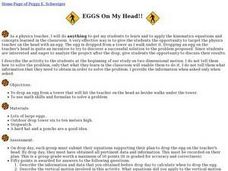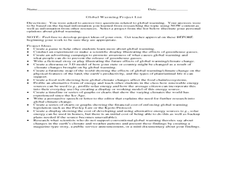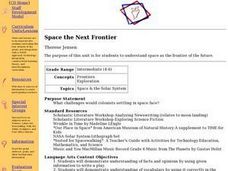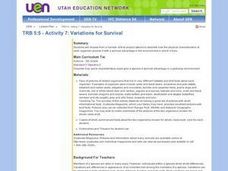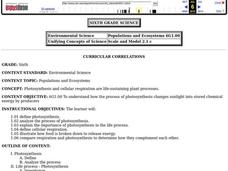Curated OER
Marine Protected Areas
Learners design a research project about a Marine Protected Area they chose. In this marine biology lesson, students gather fish count and catch data then graph them. They create an information poster about their findings.
Curated OER
Kinetic and Potential Energy
Young scholars calculate kinetic and potential energy in the lab. In this physics lesson, students demonstrate how energy can be transformed from one form to another. They collect data from the experiment and write a detailed lab report.
Curated OER
Eggs On My Head
Students apply math skills using formulas to solve a Physics equation. Working individually, students create an equation to calculate the drop rate of an egg from a tower so it will hit a specified target, the teacher. Students test...
Curated OER
Exercise What Can I Do For My Heart?
Fifth graders comprehend the benefits of daily physical activity and are taught the factors that affect physical performance. They relate ways that aerobic exercise strengthens and improves the efficiency of the heart and lungs. ...
Curated OER
Boomerang
Learners build their own boomerang. In this physics lesson, students trace the origin of this equipment. They practice throwing and catching them.
Curated OER
Laser
Eleventh graders explore the different steps in the engineering process. In this physics instructional activity, 11th graders design an experiment based on topic given. They prepare a presentation and share it with the class.
Curated OER
How We Use Rocks: Part 1
Second graders read books about rocks, observe rocks and locate a special rock to observe more closely. They complete a worksheet about the chosen rock and create an art project using rocks or pebbles.
Curated OER
The Periodic Table
Students research an assigned element using the library, an encyclopedia, the Internet and other appropriate resources in order to write a research paper, a project, and an oral presentation.
Curated OER
Cosmic Rays
Students study cosmic rays and the energy behind them. In this atmospheric lesson students complete a cosmic ray telescope project.
Curated OER
Mighty Minerals
Students investigate the physical and chemical characteristics of minerals. They make a list of the uses of minerals found in Illinois. They write a report individually based on their observations.
Alabama Learning Exchange
This Is How We Roll!
Students research how roller coasters work. In this physics instructional activity, learners research the history of roller coasters and the safety factors in the design of a roller coaster on the website...
Alabama Learning Exchange
Coral Reefs
Study explore coral reefs. In this coral reef lesson, 4th graders examine the physical structure of coral reefs. Students consider why coral reefs need to be protected and ways to protect them.
Curated OER
Newton's Laws of Motion
Learners investigate the effect of thin films to surface friction. In this physics lesson, students calculate the coefficient of friction using mathematical formulas. They discuss its importance in their everyday lives.
Curated OER
Lesson Plan: Global Warming
Students explore the concept of global warming. For this climate change lesson, students explore the provided links to PBS NOW sources and research the greenhouse effect and the effects of global warming. Students support their...
Curated OER
Space the Next Frontier
Young scholars examine the use of space as the frontier of the future. Using the colonist's experience coming to the New World, they identify challenges they would face if they were to settle in space. As a class, they share what they...
Curated OER
What Is In The Water?
Students investigate the biotic and abiotic factors that are found in an aquatic ecosystem. The emphasis is upon the investigation of present an projections of future water quality. Then students visit a local body of water to gather...
Curated OER
Eggs: A Practical Application
Students examine the chemical and physical nature of eggs and their role in food preparation.
Curated OER
Variations for Survival
Fifth graders examine two related organisms that live in different environments and compare how the physical characteristics of each organism provided it with survival advantages unique to its own environment.
Curated OER
Ecology: Factors Influencing Animal Populations
Students assess the factors affecting animal populations. Working in groups they define specific vocabulary terms and complete several activities from "Project Wild."
Curated OER
Photosynthesis
Sixth graders are introduced to the process of photosynthesis by discussion and then by participating in an experiment. They then answer questions as independent practice project.
Curated OER
SEM/EDS Beach Sands
Pupils pose a question that can be answered using the SEM and sand they collected from beach profiles. Then, they use the SEM to answer their question or test their hypothesis. Students design a small testable project and demonstrate...
Curated OER
The Life Cycle of the Butterfly
Second graders study the life cycle of a butterfly by observing metamorphosis taking place in a butterfly pavilion. Students illustrate their understandings of the body parts of a caterpillar and butterfly, as well as the life cycle,...
Curated OER
Anatomy What Does the Heart Do?
Second graders identify the major parts of the heart and comprehend the basic function of the heart. They identify the heart in relation to other major structures in the body, including the lungs, brain, and stomach. Students identify...
Curated OER
Chucky Chickadee: Bird and Breakfast Meet the Winter Friends
Pupils compare and contrast the attributes of winter birds. In this winter bird lesson, students examine the physical attributes of Black-capped Chickadees, Cardinals, Blue Jays, Flickers, Juncos, Nuthatches, and Tufted Titmouses as they...


